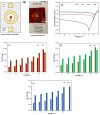The Light Wavelength, Intensity, and Biasing Voltage Dependency of the Dark and Photocurrent Densities of a Solution-Processed P3HT:PC61BM Photodetector for Sensing Applications
- PMID: 39330653
- PMCID: PMC11435158
- DOI: 10.3390/nano14181496
The Light Wavelength, Intensity, and Biasing Voltage Dependency of the Dark and Photocurrent Densities of a Solution-Processed P3HT:PC61BM Photodetector for Sensing Applications
Abstract
The promising possibility of an organic photodetector (OPD) is emerging in the field of sensing applications for its tunable absorption range, flexibility, and large-scale fabrication abilities. In this work, we fabricated a bulk heterojunction OPD with a device structure of glass/ITO/PEDOT:PSS/P3HT:PC61BM/Al using the spin-coating process and characterized the dark and photocurrent densities at different applied bias conditions for red, green, and blue incident LEDs. The OPD photocurrent density exhibited a magnitude up to 2.5-3 orders higher compared to the dark current density at a -1 V bias while it increased by up to 3-4 orders at zero bias conditions for red, green, and blue lights, showing an increasing trend when a higher voltage is applied in the negative direction. Different OPD inner periphery shapes, the OPD to LED distance, and OPD area were also considered to bring the variation in the OPD dark and photocurrent densities, which can affect the on/off ratio of the OPD-LED hybrid system and is a critical phenomenon for any sensing application.
Keywords: LED; dark current density; on/off ratio; organic photodetector; photocurrent density.
Conflict of interest statement
Kentaro Harada, Hin-Wai Mo and Hiroshi Fujimoto are employed by the company OPERA Solutions Inc. The remaining authors declare that the research was conducted in the absence of any commercial or financial relationships that could be construed as a potential conflict of interest.
Figures










References
LinkOut - more resources
Full Text Sources

